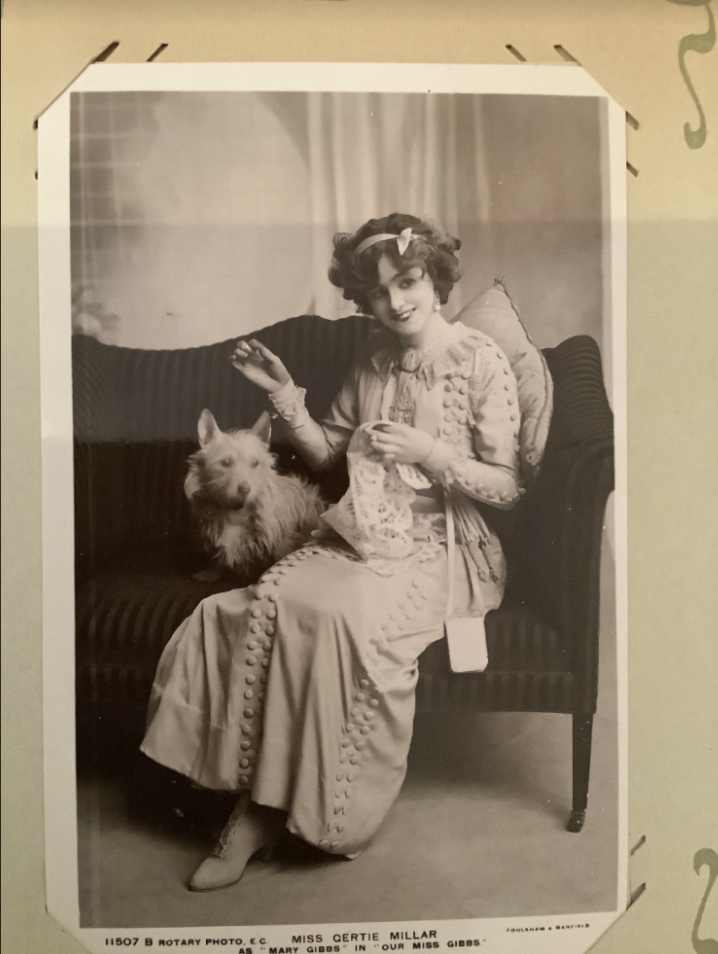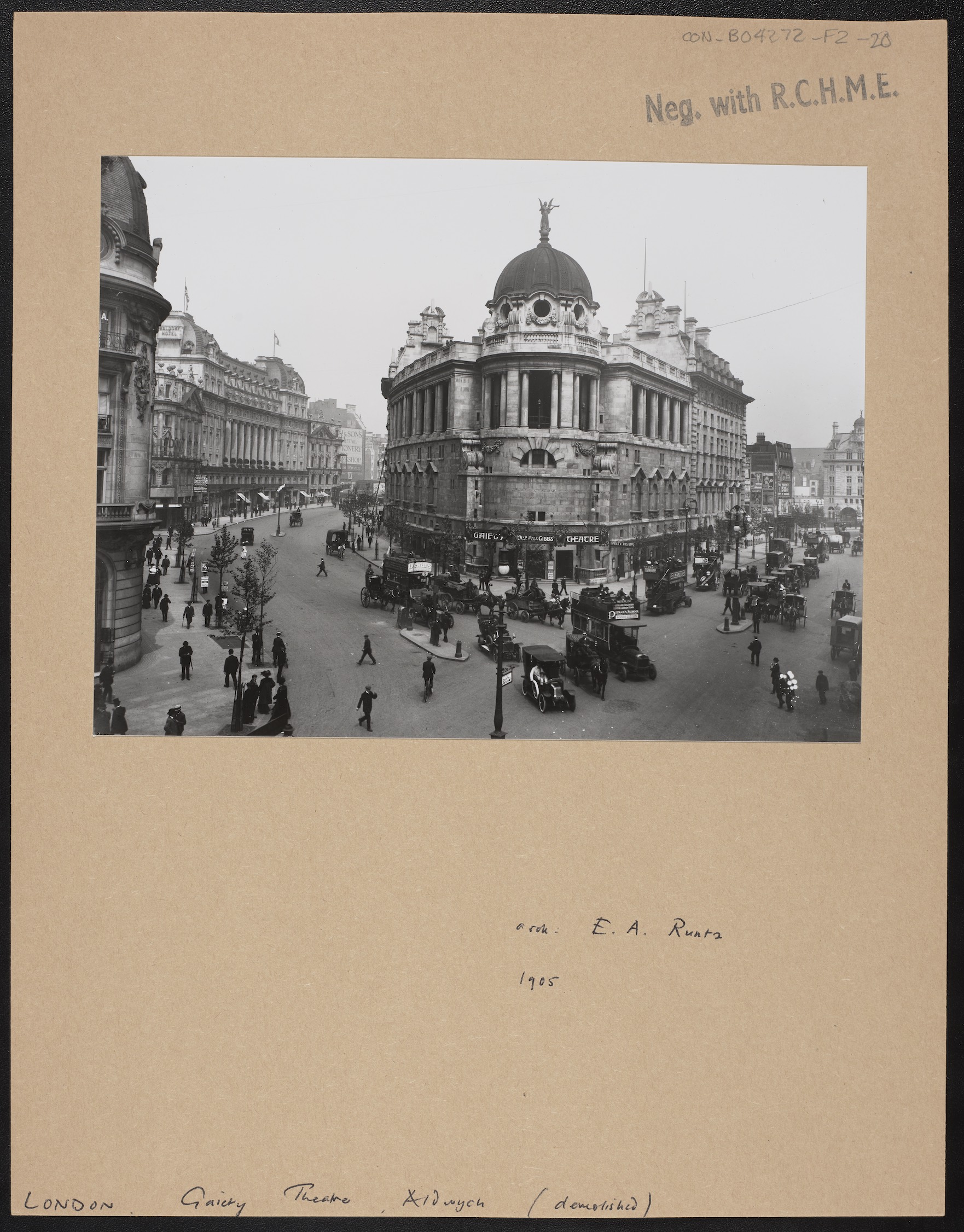The Gaiety Theatre 1909
My story is about two women.
One began her life and career in the north of England, before travelling to London to find success in the West End.
The other began her life in south Asia before travelling to England to reach the heights in London theatre.
One would be found in front of an adoring public on the stage of the Gaiety Theatre; the other spent 56 years blowing her trumpet to the heavens from the dome of the theatre – only occasionally spotted through the grimy London air.
This musical comedy production, ‘Our Miss Gibbs’, was a huge hit for the Gaiety Theatre and the star of the show was our first leading lady, Gertie Millar, who played the eponymous Miss Gibbs – a shop girl in a large London department store, Garrods. From a working-class background herself, (father a millworker and mother a dressmaker) Gertie’s career began in the 1880s with performances as a child in pantomimes in Manchester and London. She moved to singing and dancing in northern music halls, then found more fame and higher pay in London variety shows.

The zenith of Gertie’s career was achieved through her successful partnership with George Edwardes, the manager of the original Gaiety Theatre in the first two decades of the 20th century. In 1903 the new, rebuilt Theatre opened, Gertie played the lead in the long-running opening production, ‘The Orchid’, watched from the royal box by King Edward VII and Queen Alexandra.
Musical comedy was a hugely popular form of British theatre in the early 20th century, and Gertie was one of the top performers, not only in the London theatres but also on Broadway – taking New York by storm in her performances in ‘The Girls from Gottenburg’ in 1908. She was also one of the most photographed women of the age, appearing on numerous postcards. ‘Our Miss Gibbs’ was a typical Gertie Millar success story – running for 636 performances before transferring to Broadway in 1910.
Our second leading lady is The Spirit of Gaiety, designed by Hibbert C. Binny, constructed at his workshop in Essex and positioned on top of the dome of the newly rebuilt Gaiety Theatre in 1903. She is made from blocks of carved teak, gilded, weighs more than a ton and is 20 feet high – quite a show stopper.
In 1939, the theatre was scheduled for demolition to accommodate a road widening scheme. The Spirit of Gaiety oversaw the last performance (‘Running Riot’) on 25th February 1939. However, the road widening scheme was discarded, partly due to WW2, and the theatre stood abandoned and increasingly derelict. Astonishingly, despite bomb damage in The Blitz, the statue remained standing – resilient and proud.
After the war, the famous comic actor Lupino Lane bought the building, hoping to restore it to its former glory. Unfortunately, despite spending huge amounts on restoration works, Lane realised he had in fact bought a money pit, which he did not have the resources to fill. In 1950 he had to sell the property. The theatre was demolished and the English Electric Company building was constructed on the site. Although she lacked a theatre, The Spirit of Gaiety still remained on the site, if somewhat lower in status and height. She was preserved and stood in the well of the Citibank premises until 1984 when she was presented to the Theatre Museum in Covent Garden where she began her 3rd life – on display in the main entrance until 1992, as concerns about her condition caused her to be taken off display and moved into storage. She came to rest at the Victoria and Albert Museum.
Gertie’s private life was also entwined with the theatre: in 1902 she married Lionel Monckton, 20 years her senior, the man who had first spotted her performing and recommended she come to London. A theatrical composer, he wrote several of her best known songs, including ‘Moonstruck’ for ‘Our Miss Gibbs’. He was, however, a jealous man who disliked seeing his beautiful wife enjoying attentions from many of the ‘stage door johnnies’. The couple separated, but Monckton refused to give his wife a divorce even though she desperately wanted to marry the Duke of Westminster, with whom she was having an affair. Eventually King George V and Queen Mary were compelled to step in to prevent the scandal that would have erupted had the Duke had to divorce his wife to marry Gertie.
Meanwhile, theatrical tastes began to shift – in WW1 audiences began to prefer new entertainment in the form of films as well as music hall. George Edwards died in 1915, and Lionel Monckton’s style of song was increasingly dated. She achieved a few successes after 1912, but never again had the consistent acclaim of her early career, so in 1918 she retired from the stage. Her final performance was fittingly in the theatre of her home town – the Bradford Alhambra.
Gertie had by then embarked on a liaison with the 2nd Earl of Dudley. His wife died in 1920, and Lionel Monckton succumbed to illness in March 1924, so in April 1924, at last Gertie became the Countess of Dudley. She and her new husband spent most of their short married life in Le Touquet, not far from their neighbour, friend and fellow theatrical writer – P.G. Wodehouse. The Earl of Dudley died in 1936, while Gertie, still a countess, lived on in Surrey, until 1952, on her death leaving a substantial estate.
The Spirit of Gaiety on the other hand, has outlived the era of the Gaiety Girl, epitomised by Gertie Millar, and resides at the end of the Paintings galleries on the first floor of the V&A. Years of exposure to rainwater had left her internal framework heavily corroded and woodwork weakened. Urgent work was required, before an extensive treatment programme could progress, strengthening the rotten woodwork and reinstating her gilded surface – carried out by lead conservator Zoe Allen, who calls the statue one of her favourite objects. She was given this level of care as she is something of a rarity – wooden architectural sculpture doesn’t often survive. Size, weight, exposure to the elements mean few are preserved intact when the buildings they grace are demolished. The Spirit of Gaiety is therefore considered by the V&A to be unique within UK museum collections. She now has a new name – the V & A staff affectionately call her the Angel. Restored and renewed, she is once again visible to many visitors as well as staff who can all appreciate the joy and gaiety she represents.
This is the text to a presentation that was part of the Conway Storytellers in the Being Human Festival in 2021.
Kathleen Lynch-Howard, Digitisation Volunteer, November, 2021




